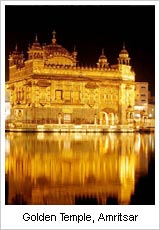Introduction:
O'Dwyer's killing marked the end of a chain of events that
began, in a sense, at 4:30 p.m. on April 13, 1919, when Brigadier
General Reginald Dyer opened fire on an unarmed gathering
in Jallianwala Bagh. Udham Sigh was a witness to that carnage.
Through 21 years of revolutionary activity in the United Kingdom,
the United States, Africa and India, Udham Singh saw avenging
the massacre as his destiny. Jallianwala Bagh radicalised
an entire generation and laid the foundation for Punjab's
vigorous secular political traditions. The traditions forged
by Udham Singh and his peers are as relevant now as they were
seven decades ago.
The British General Dyer was the Lieutenant Governor of the
province in 1919. He banned all meetings and demonstrations
led by Indians against the economical set back by World War
I. On 13 April 1919, pilgrims poured into Amritsar to celebrate
the Baisakhi festival, a holiday in the Sikh calendar. In
the afternoon thousands of people gathered at Jallian Wala
Bagh to celebrate the Baisakhi. This ground surrounded by
high walls on all sides has only a narrow alley for access.
General Dyer personally led the troops to the sight and ordered
his men to open fire without any warning. It resulted in the
death of 379 and injured more than 1200. India was outraged
by Dyer's massacre. Gandhiji, called for a nation wide strike
and started the Non-cooperation Movement, which became an
important mile stone in the struggle for India's Independence.
Today this ground has been changed to a park and it has a
pleasant garden.
There is a narrow path between the houses which leads to the
lawn of the park. At the entrance there is a memorial plaque
which recounts the history. There is a well on the north side
in which many people who tried to escape from the bullets
were drowned, and remnants of walls have been preserved to
show the bullet holes. At the east end of the garden there
is a large memorial built in memory of those who died here.
Eyewitness account of the merciless massacre beggar description.
As the machine guns started raining bullets, the dead piled
on the dead and wounded upon the wounded. There being no exit,
there was a general stampede; women and children being crushed
under the heels of those who trying to escape firing. The
wailing of women and crying of children were drowned in the
fearful blast of the guns spewing fire. General Dyer's loyal
soldier released their triggers only when they had exhausted
their ammunition. And then leaving the dead and the wounded
where they were, Dyer left the ghastly scene along with his
troops. Far from attending to the wounded, there was none
to offer even water to the dying. According to the official
version, 379 people were killed on the spot and thrice as
many wounded to die later. The unofficial number of the dead
runs into four figures. |
|
 |

